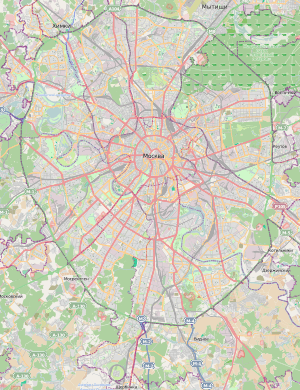Gorky Park (Moscow)
| Gorky Park | |
|---|---|
 Main portal of the Gorky Park | |
 Location in Moscow | |
| Location | Moscow, Russia |
| Coordinates | 55°43′42″N 37°36′0″E / 55.72833°N 37.60000°ECoordinates: 55°43′42″N 37°36′0″E / 55.72833°N 37.60000°E |
| Area | 300 acres (120 ha) |
| Open | 1928 |
| Public transit access |
1 Vorobyovy Gory 1 Park Kultury 5 Park Kultury 5 Oktyabrskaya 6 Oktyabrskaya 6 Leninsky Prospekt 14 Ploshchad Gagarina |
| Website | Gorky Park |
Gorky Central Park of Culture and Leisure (Russian: Центральный парк культуры и отдыха (ЦПКиО) имени Горького, tr. Tsentralny park kultury i otdykha imeni Gorkogo, IPA: [tsɨnˈtralʲnɨj ˈpark kʊlʲˈturɨ i ˈoddɨxə ˈimɪnɪ ˈɡorkova]) is a central park in Moscow, named after Maxim Gorky. In August 2018, the Park's 90th anniversary was celebrated.[1]
History

Gorky Park, located at Krymsky Val and situated just across the Moskva River from Park Kultury Metro station, opened in 1928. The park followed the plan of Konstantin Melnikov, a widely known Soviet avant-garde and constructivist architect, and amalgamated the extensive gardens of the old Golitsyn Hospital and of the Neskuchny Palace, covering an area of 300 acres (120 ha) along the river.[2] The history of the Neskuchny Garden can be traced back to 1753, when it emerged in the area between Kaluzhskaya Zastava and Trubetskoy Moskva river-side estate. The neighboring area to Neskuchny Garden, from Krymsky Val to Neskuchny Garden, received little attention right up until the 1920s. Initially it was covered with park gardens, meadows and vegetable gardens belonging to the owners of neighboring estates. It formed a wasteland by the end of the 19th century, and served as a waste heap.
The First All-Russian Agricultural and Handicraft Industries Exhibition opened in 1923 on the wasteland that had been cleared during the course of communist community work days. A resolution for the exhibition was passed on 19 October 1922 and the exhibition opened one and a half years later on 19 May 1923. After bidding for the exhibition's layout plan, which proposed four arrangements — Sokol, Khodynskoye Pole, Petrovsko-Razumovsky park and the river areas near Krymsky bridge — preference was given to the last option.
On 15 March 1928 by a resolution of the Presidium of the Moscow Council, the Agricultural and Handicraft Industries Exhibition was enlarged and transformed into the Central Park of Culture and Leisure — the country’s first park of its kind, which was referred to as an outdoor "cultural enterprise". In 1932 the park was named after M.A. Gorky. The idea of a need for a central park of culture and leisure in Moscow arose in the late 1920s in relation to Moscow's reconstruction with notions of a socialist "city of the future".
Transformation

In 2011 Gorky Park underwent a major reconstruction. New director of Central Park of Culture and Leisure Sergei Kapkov demolished approximately 100 attractions and illegal objects. More than two thousand square meters of new asphalt roadbed was laid on the site of demolished objects and 1.9 ha of new lawns and flowerbeds were laid out. All amusement rides but one, a two deck carousel, have been removed in order to transform the place into an eco-friendly recreational zone. Free entry, Wi-Fi coverage, new zones of contemporary design, a well thought-out events program have transformed Gorky Park into one of the epicenters of life in the capital. In order to create something new, it was necessary to clean the park of abandoned buildings, carts, tents, advertising structures and attractions. Renovation of monuments, cleaning the ponds and delivering soil and grass turf started. Gorky Park was transformed in several months, becoming the first Russian park that could now compete with the leading parks of the world. A 15,000 square meter ice rink, with separate zones for children, hockey, dancing, and general skating, was officially opened in December 2011.
Shortly after he took over the park, Sergei Kapkov was appointed to the role Moscow Government Minister and Head of the Department of Cultural Heritage. Olga Zakharova had replaced Sergei Kapkov and has been holding the position ever since. [2]
In popular culture
- The park was described in the novel Gorky Park by Martin Cruz Smith. It was later made into a film with the same name.
- The German hard rock band Scorpions achieved great success with their popular single, "Wind of Change", which references Gorky Park[3] in light of the sociopolitical changes taking place in a post-Cold War era in Eastern Europe in the early 1990s.
- A Russian rock band Gorky Park is named after the park.
- Gorky Park is mentioned in the song "Vodka"[4] by Morena, which represented Malta in the Eurovision Song Contest 2008.
- A CIA agent brush-passes a Russian agent in Gorky Park at night in the 2018 film Red Sparrow.
- The park was mentioned in Episode 6 of Season 3 of the web series House of Cards
- The park was mentioned in Episode 8 of Season 2 "New Car" and Episode 3 of Season 5 of the FX original series The Americans (2013 TV series)
References
- ↑ https://www.dw.com/en/moscows-gorky-park-celebrates-90th-anniversary/av-45204257
- 1 2 Gorky Park in Eagle, Russia Retrieved on 2013-10-25.
- ↑ Scorpions - Wind Of Change Retrieved on 2015-07-04.
- ↑ Eurovision 2008 - Malta (Vodka) By Morena Retrieved on 2009-09-27.
External links
| Wikimedia Commons has media related to Gorky Park (Moscow). |